[ad_1]

Laurence Dutton/E+ via Getty Images
(This article was co-produced with Hoya Capital Real Estate)
Introduction
For investors who must take RMDs due to age or inheriting an account, having equities that generate income to cover those withdrawals could be a goal they have. Yes, they can sell shares or, if allowed, do an in-kind transfer, but both of those actions reduces the equities held in the account.
While doing my annual due diligence on my WisdomTree International Hedged Quality Dividend Growth Fund (IHDG), I always look for Peers to evaluate the possibility of switching ETFs. Sometimes times there is one fund that warrants an article on Seeking Alpha for readers as a possible “Avoid”. When I started reviewing the Fidelity International High Dividend ETF (FIDI), I though it fit that description. While FIDI has one of the highest yield, its Total Return is negative since inception in 2018. More research changed my opinion. Owners of FIDI should consider holding on. While the 3-year CAGR trails iShares International Select Dividend ETF (IDV), a leading performer in the same market segment, badly, the past year shows it outperforming its older and larger rival. I will also list some others investor might consider at the end of this article.
Taking a Deep Dive into the Fidelity International High Dividend ETF
Seeking Alpha describes this ETF as:
Fidelity International High Dividend ETF is an exchange traded fund launched and managed by Fidelity Management & Research Company LLC. It is co-managed by Geode Capital Management, LLC. It invests in public equity markets of global ex-US region. The fund invests in stocks of companies operating across diversified sectors. The fund invests in growth and value stocks of companies across diversified market capitalization. The fund invests in dividend paying stocks of companies. The fund seeks to track the performance of the Fidelity International High Dividend Index. FIDI started on 1/16/2018.
Source: seekingalpha.com FIDI
FIDI has accumulated $92m in assets. The ETF currently yields 3.8%. Fidelity charges 39bps in fees. The ETF invests based on an in-house index: Fidelity International High Dividend Index, which they described as:
The index is designed to reflect the performance of stocks of large- and mid-capitalization developed international high dividend-paying companies that are expected to continue to pay and grow their dividends.
Source: institutional.fidelity.com
FIDI Holdings review
Country exposure shows nice disbursement across the globe with 52% in Europe and 29% in Asia. They have no Emerging Market exposure.
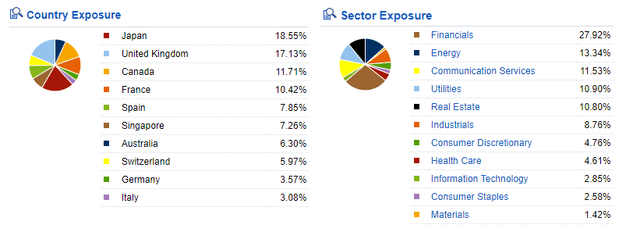
Fidelity.com FIDI
With the exception of the 28% allocation to financial stocks, the next highest concentration is only 13%, in Energy. Those two sectors provide some of the best yields, thus the 41% combined weight. The Financial sector stocks are about evenly divided between banks and insurance companies.
Largest Holdings
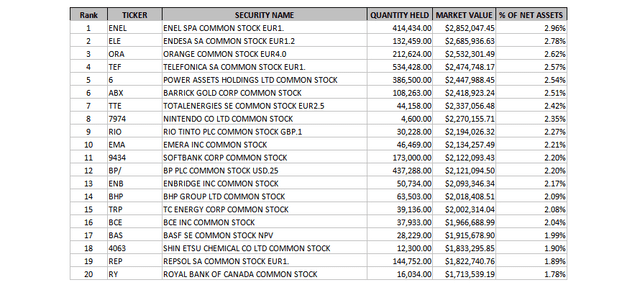
Fidelity.com; compiled by Author
The stocks listed above account for 45% of the portfolio weight. The ETF currently holds 100 stocks, 10 non-USD currency contracts, and MSCI EAFE futures. The currency contracts are designed to reduce the currency risk of the portfolio. While the Index description mentions Mid-Cap stocks are included, less than 14% of FIDI is currently invested in those stocks.
FIDI Distribution review

seekingalpha.com DVDs
Over its short 4-year life, dividends have varied in a narrow range, showing little growth. Seeking Alpha’s dividend grading system gives FIDI a “C”.

seekingalpha.com DVD scorecard
Reviewing a competitor: iShares International Select Dividend ETF
Seeking Alpha describes this ETF as:
The fund is managed by BlackRock Fund Advisors. The fund invests in public equity markets of global ex-US region. The fund invests in stocks of companies operating across diversified sectors. The fund invests in growth and value stocks of companies across diversified market capitalization. The fund invests in dividend paying stocks of companies. It seeks to track the performance of the Dow Jones EPAC Select Dividend Index. IDV started in 2007.
Source: seekingalpha.com IDV
IDV is much bigger at $4.5b in assets. IDV has a better yield at 5.6%. At 49bps, the fees reflect the higher costs of running a non-US invested ETF.
Dow Jones describes their Index as:
The Dow Jones EPAC Select Dividend Index aims to represent the performance of high dividend-paying companies in the EPAC (Europe, Pacific, Asia and Canada) region, which covers developed markets excluding the U.S.
Source: spglobal.com Index
For this Index, I found some basic inclusion/construction rules:
- The index universe is defined as all constituent companies of the developed-market country sub-indices of the S&P Global BMI, excluding REITs.
- The company must have paid dividends in each of the previous three years.
- Dividend-per-share greater or equal to the three-year average dividend-per-share.
- A five-year average dividend coverage ratio greater than or equal to two-thirds of the five-year average dividend coverage ratio of the corresponding S&P BMI country index, or greater than 118%, whichever is greater.
- The top 100 stocks by indicated dividend yield are selected to the index, subject to buffers designed to limit turnover by favoring current index constituents.
- Calculate the final constituent weight by multiplying the IAD weight of each constituent by its respective yield country weight.
IDV Holdings review
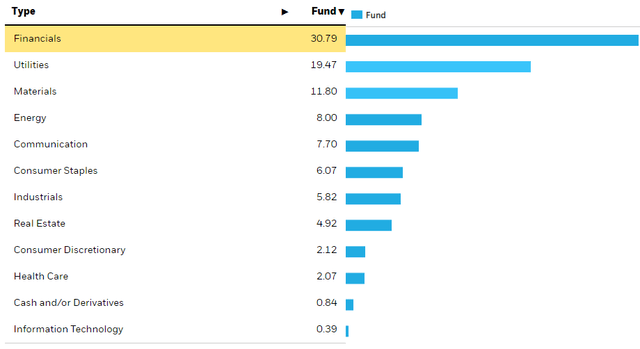
iShares.com
The comparison section later will review how these match FIDI’s allocations. With REITs excluded, the 4.92% in Real Estate comprises other types of exposure to that sector.
The Top 10 holdings are:
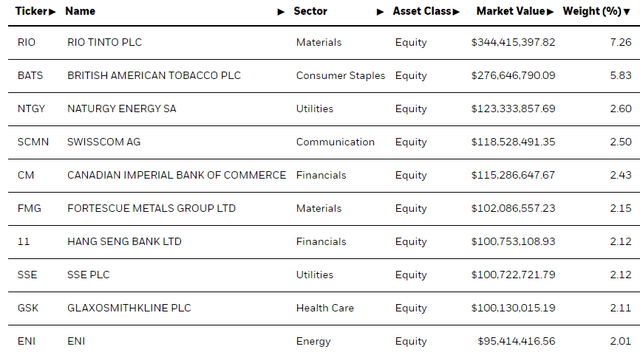
iShares.com
There are 120 holdings in IDV, with the Top 10 representing about 31% of the assets, with the Top 20 at 47%; slightly more concentration than FIDI has.
IDV Distribution review

seekingalpha.com IDV DVDs
The erratic payouts reflect the fact some foreign countries, notably Japan, only do semi-annual, not quarterly payouts. Seeking Alpha grades their history as “A-“.

seekingalpha.com DVD scorecard
Comparing ETFs
This first chart, dating from when FIDI started in early 2018, shows why the FIDI ETF earns a Hold rating.
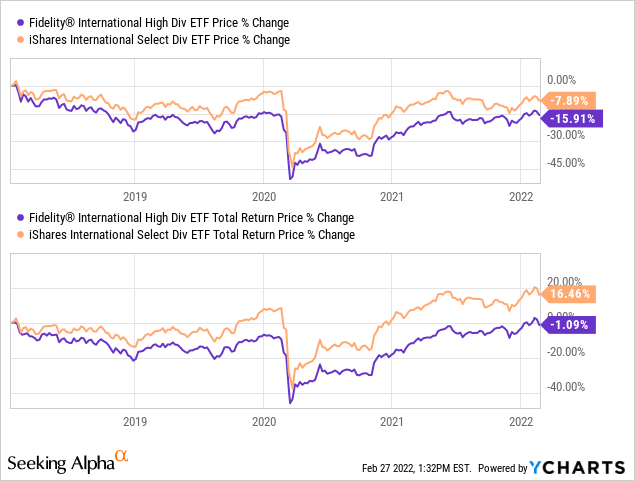
Both price-only but more importantly, Total Return shows better results for IDV. Things could be changing though, as the 1-year results as FIDI is ahead in both metrics.
The next chart shows why investors need to go beyond the fund’s name to understand what the own or are considering owning. Despite both investing in higher yielding international stocks, their holdings have little in common. FIDI is weighted to larger stocks, with a WAMC of $58b versus $41b for IDV. For stocks with a market-cap over $10b, FIDI is at 86%; IDV at 70%. Another difference is IDV has 7% in EM stocks; FIDI has 0%.
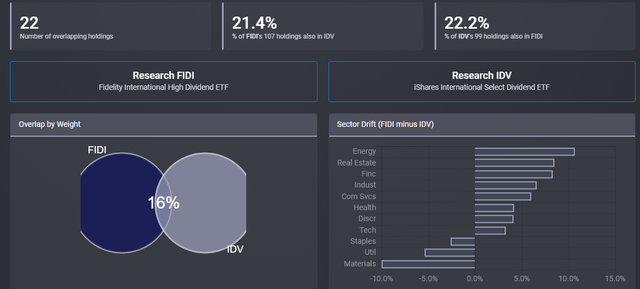
ETFRC.com
With 3 of 4 biggest sector differences favoring FIDI, it helps explain why in the last year they outperformed IDV, as all three were top performers.
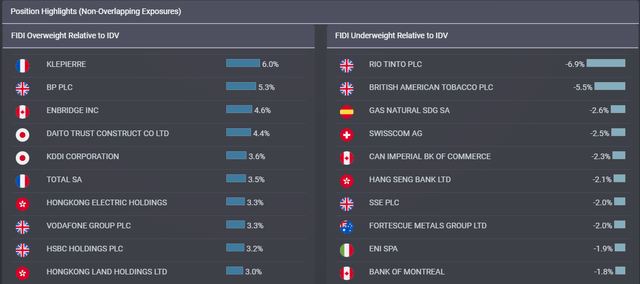
ETFRC.com
Those sector weight differences really show when comparing which individual stocks differ in the weights held. These are some of the widest I have seen when running tis screen.
For the next chart, I added three other players in this market segment to give a better picture of how FIDI and IDV fit into the wider universe of similar ETFs.
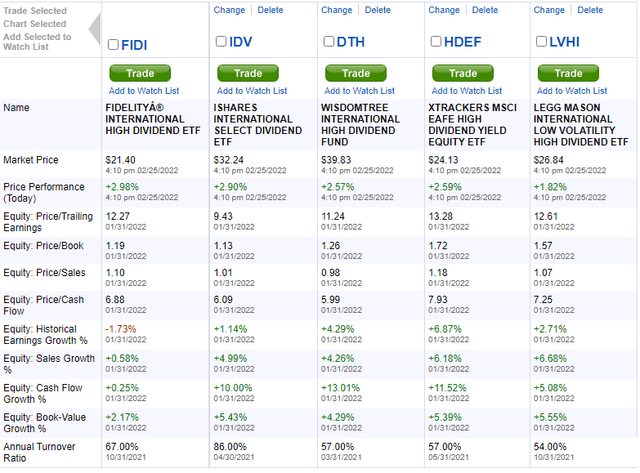
Fidelity.com
While most of the Price ratios are in a narrow range, FIDI’s growth percent are the worst across all five ETFs shown. Even, as an investor, I liked its sector allocation, I would check out the others to see if I could keep those exposures but gain better growth metrics.
Portfolio Strategy
The comparison part of this article points out the importance of looking “under the hood” of any fund you want to own as funds with the same investment concept can invest very differently. Exploring the index rules, usually available in a Methodology PDF on the index provider’s website, is a good starting point. Even after calling Fidelity, no such PDF was available for the index used by FIDI. Seeking Alpha provides a Peers function that will compare the fund of your choice against five others; which you then can edit to your likening. Here is what I get when entering FIDI.

seekingalpha.com Peers
A second comparison when considering a factor-based ETF like FIDI, is to compare it against a pure ETF that invest in the same market sector. Here I compared FIDI against the iShares Core MSCI International Developed Markets ETF (IDEV) since it also avoids EM stocks.
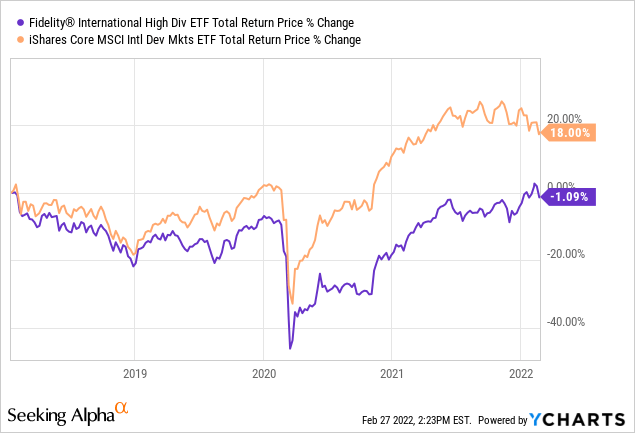
IDEV’s yield is 3% versus the 3.8% FIDI provides but more than makes up for that in performance. Investors considering FIDI would do well to look deeper into IDEV or one of the ETFs listed next to see which ETF best matches up against their investment goals.

Hoya Capital Income Builder
[ad_2]
Source links Google News

